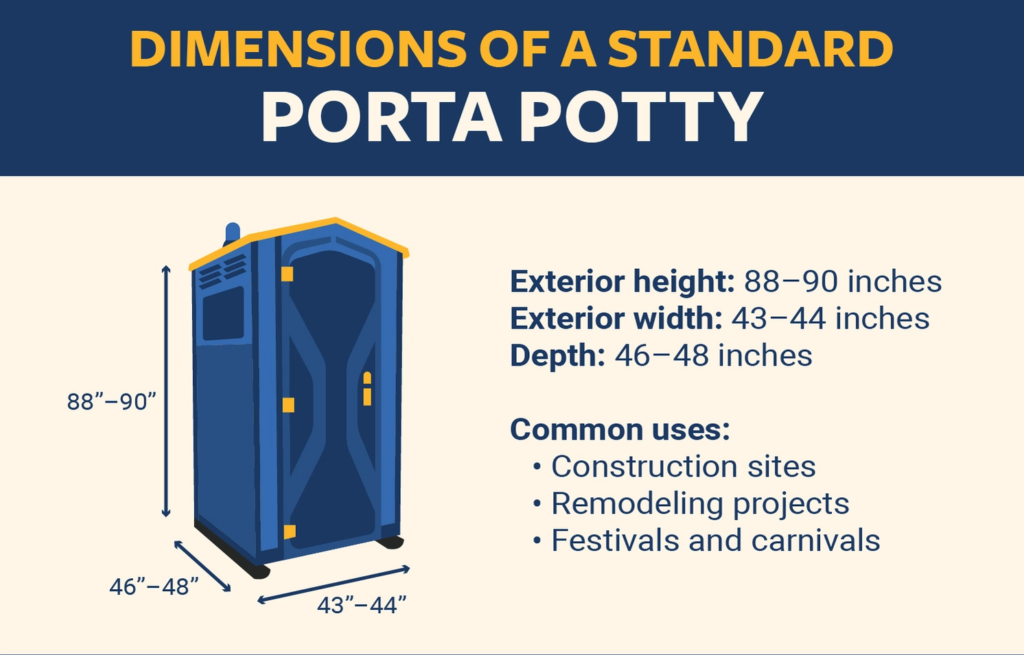Call: +1 9877 543 321
A standard porta potty is typically a prefabricated unit consisting of a holding tank, seat, and urinal mounted inside a lightweight plastic or polyethylene housing.
The housing includes a door or privacy screen, vent pipe, and roof. Standard units are approximately 43” wide x 43” deep x 88” tall and weigh around 200 lbs when empty.
The holding tank inside has a capacity of 50-60 gallons and contains a chemical solution to help control odor and break down waste.

Underneath the tank is a slanted floor with a waste valve that empties the contents. Standard units do not have running water, requiring the tank to be drained and refilled with sanitizing chemicals.
Venting helps manage odors by allowing fumes to escape through the roof vent pipe. The vent pipe also equalizes internal air pressure when the door is opened and closed. The roof provides shade and weather protection.
Standard porta potties are designed for temporary use at events lasting 1-5 days. For longer term needs, deluxe units with added features like flush toilets and sinks are available.
Uses of Standard Porta Potties
Standard porta potties provide a safe, reliable solution for basic sanitation needs at:
- Outdoor events: Anywhere large crowds are gathered outdoors for an extended period, such as concerts, festivals, marathons or bike races, you will see rows of porta potties. They provide the necessary bathroom access when permanent facilities are impractical or inadequate for the event size.
- Construction sites: On large construction sites, especially in remote areas, porta potties offer a convenient sanitary solution for workers. Units can be delivered and serviced throughout the duration of the project.
- Disaster relief: Following natural disasters that knock out water treatment facilities or damage buildings, porta potties are one of the first services brought in when setting up emergency relief shelters and operations. Providing restroom access is a top priority.
- Remote locations: Portable toilets are used anywhere people will be stationed remotely for an extended period, such as rural worksites, offshore oil platforms, campgrounds, or parks situated far from urban plumbing.
- Temporary bathroom closure: When permanent bathrooms in a building need renovating or repair, porta potties are an easy solution for the interim while facilities are unavailable.
Choosing Standard Porta Potty Units
When choosing standard porta potty units, considerations include:
- Number of units needed: Provide adequate capacity for the expected number of people. Recommendations range from 1 unit per 10-15 people at small gatherings to 1 unit per 150+ people at very large events.
- Duration of use: Estimate how long units will be needed. Standard porta potties are suitable for use of 1-5 days. Longer term needs call for deluxe units with extra features.
- Waste removal: Determine how waste will be removed. Standard tanks hold 50-60 gallons and require pumping when full. Some suppliers offer waste removal services.
- Accessibility: If handicapped access is needed, ADA compliant porta potty units are available. These have wheelchair ramps, rails, and larger interior space.
- Location: Place porta potties where they can be easily accessed from main event areas or job sites. Allow space for pump truck access.
- Climate conditions: In hot climates, consider units with ventilation systems. In cold weather, look for units with insulation.
- Special features: If hand washing is desired, units with sink basins are an option. Upgraded toilet options are also available.
- Service schedule: For multi-day needs, schedule regular cleaning, waste pumping, and sanitizing maintenance.
Typical Rental Logistics
Renting standard portable toilets is an easy process. Here are some details on typical rental logistics:
- Order: Contact a rental provider with your order details including quantity, duration, and delivery location. Allow plenty of lead time.
- Delivery Units will be delivered to your requested location and setup.
- Use: Your rental units will be available for use during your rental period. Provide restroom tissue and hand sanitizer.
- Service: Provider will periodically service units to clean and dispose of waste as included in your rental contract.
- Pickup: Units will be hauled away at the conclusion of your rental period.
Reputable rental providers make the process hassle-free with professional delivery, timely servicing, and simple pickup.
Frequently Asked Questions
Q1. How many standard portable toilets should I rent for my event?
Ans: The rule of thumb is 1 toilet per 50 people attending your event. Assess the number and types of attendees to estimate your ideal number of units. Factor in variables like event duration, alcohol consumption, and male-to-female ratio.
Q2. How often do portable toilets need to be serviced?
Ans: Standard units typically need pumping out every 4-7 uses or every 2-3 days for heavy use. Discuss ideal service frequency with your rental provider based on expected usage. Increased service means a higher rental cost.
Q3. What supplies do I need to provide for my portable toilet rental?
Ans: You will need to supply toilet tissue, hand sanitizer, and cleaning supplies like disinfectant spray and paper towels. Provide extra stock throughout your rental. Your provider can suggest amounts needed.
Q4. Can I customise standard portable toilet rentals?
Ans: Yes, many providers allow you to upgrade to add features like handwashing stations, interior lights, or upgraded toilet paper. You can also brand the exterior with custom graphics or messages. Discuss options with your rental company.
Q5. How early should I book standard portable toilet rentals?
Ans: It’s best to book units 1-2 months in advance if possible. Large events may need 6 months lead time to ensure availability. Try to give at least 2 weeks minimum notice for delivery. Holidays and event seasons require more notice.




